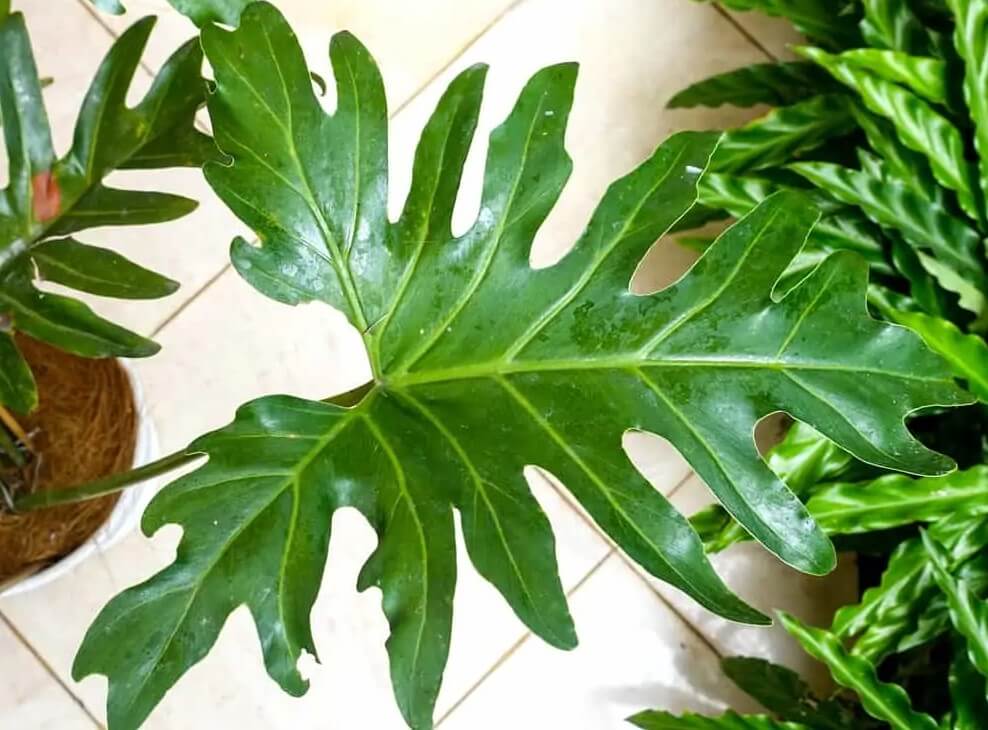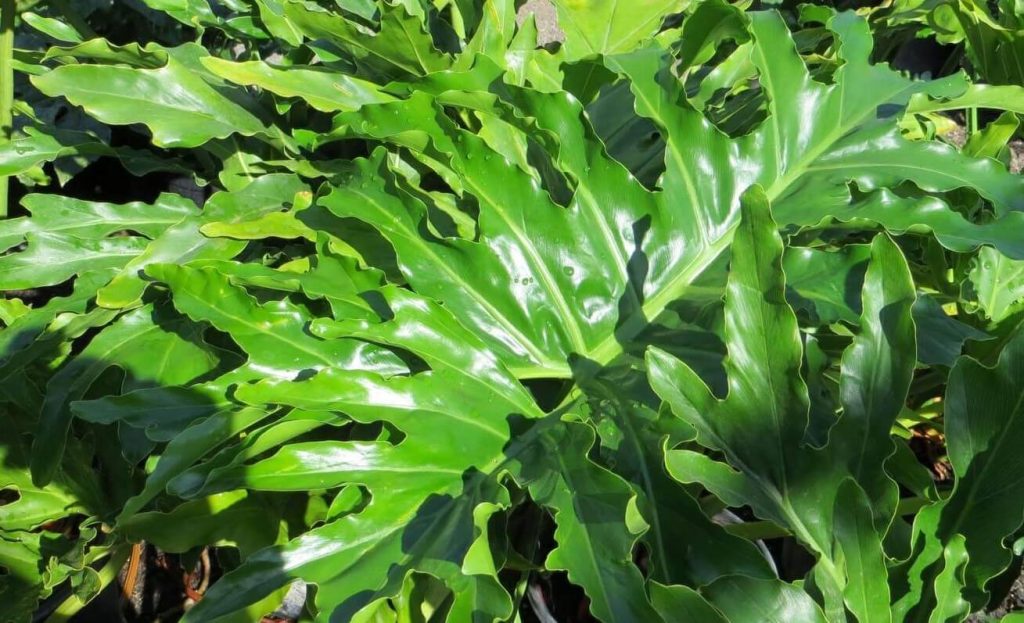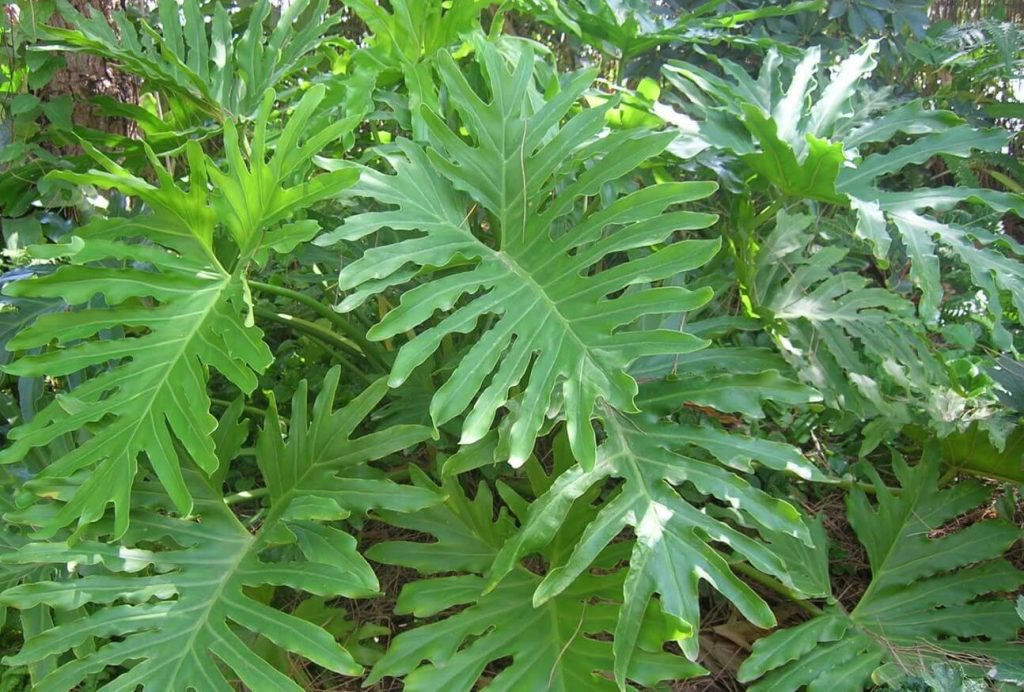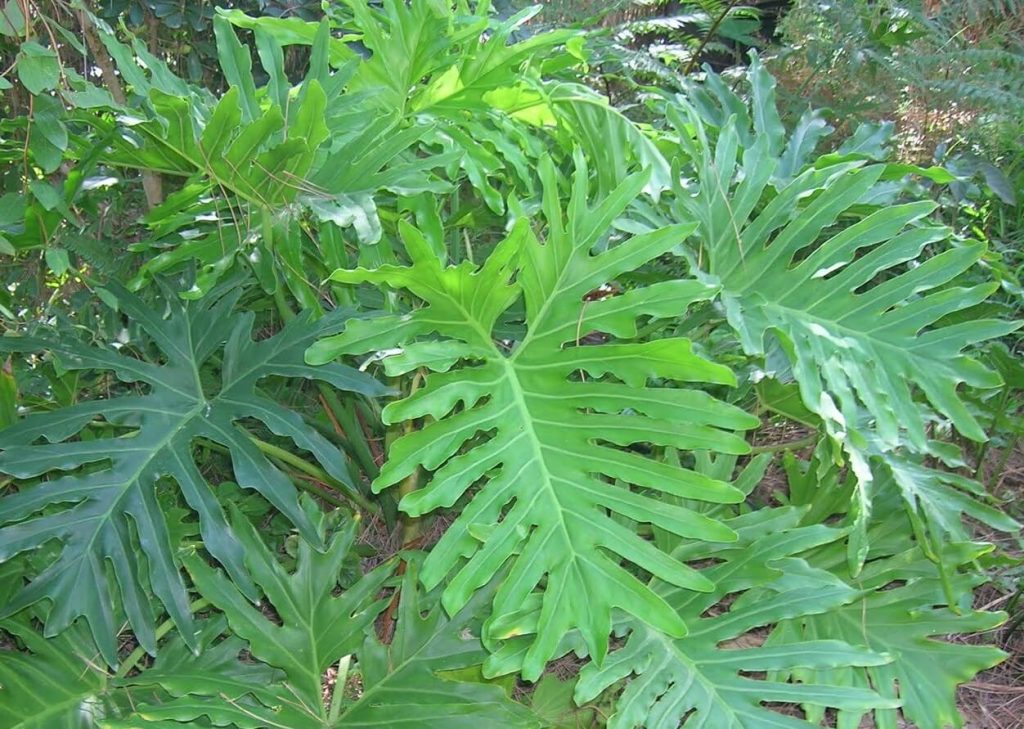Overview of Philodendron Bipinnatifidum
Philodendron bipinnatifidum is a popular tropical houseplant with big, shiny, lobed leaves. It’s also called the tree philodendron or split-leaf philodendron. This plant comes from South America and belongs to the Araceae family. It’s an evergreen perennial.
Philodendron bipinnatifidum has an exotic appearance and can grow to be quite large, making it a striking statement plant. Mature specimens can reach up to 15 feet tall in their native habitat. When grown as houseplants, they typically reach heights of 6 feet indoors.
Houseplant lovers adore Philodendron bipinnatifidum because it’s a simple, low-maintenance tropical plant. Its resilience and ability to purify indoor air makes it a staple houseplant for many homes and offices.
Native Habitat
In the wild, Philodendron bipinnatifidum is native to the tropical rainforests of South America. Its natural range includes parts of Brazil, Bolivia, Argentina, and Paraguay.
Philodendron bipinnatifidum thrives in the warm, humid environment of the rainforest understory. It grows beneath the forest canopy, where it receives bright, filtered light. These tropical plants appreciate consistent moisture and humidity.
Philodendron bipinnatifidum naturally climbs trees and surfaces with aerial roots. Outdoors, it can reach towering heights above 15 feet. The large, deeply lobed leaves unfurl to catch sunlight filtering down through the rainforest canopy.
Though Philodendron bipinnatifidum hails from the tropics, it can adapt well to life as an indoor houseplant. With proper care, these tropical beauties can grow large and grace any home with their jungle-like vibes.
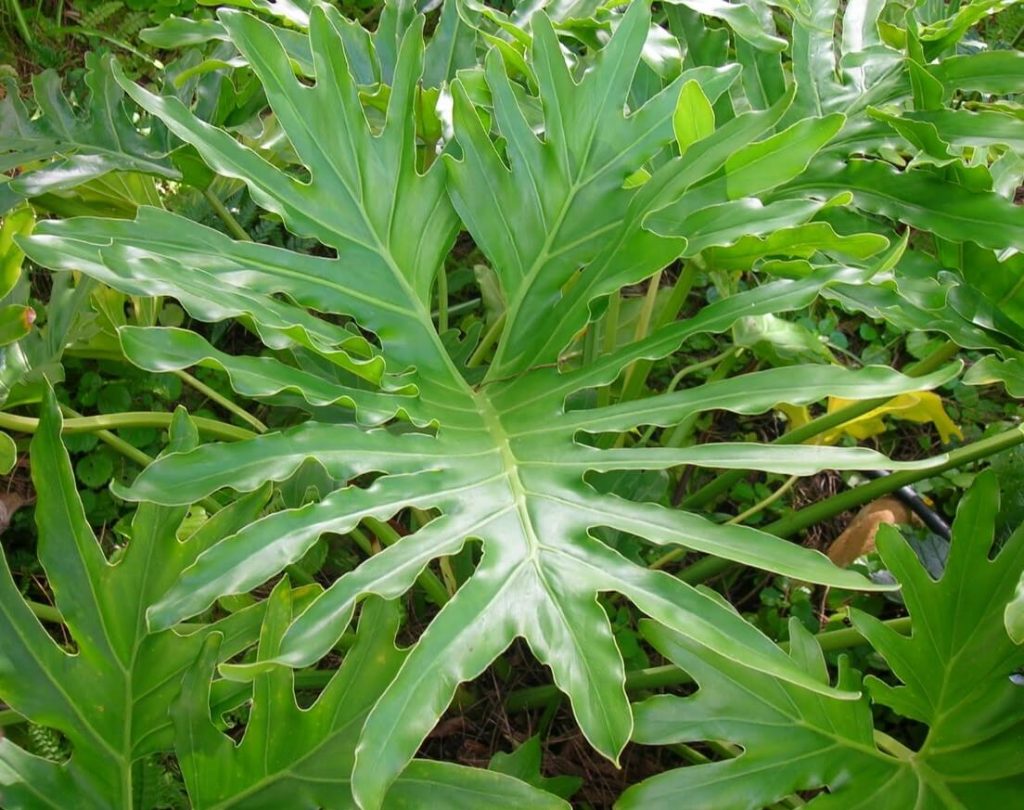
Light Requirements
Philodendron bipinnatifidum thrives in bright, indirect sunlight. This allows the plant to receive ample light without getting scorched by direct sun rays.
Prefers Bright, Indirect Light
Philodendron bipinnatifidum does best when placed in a spot that receives bright, filtered light all day long. East or west-facing windows are ideal, providing a few hours of gentle morning or afternoon sun. Bright light keeps the leaves vibrant and lush. Insufficient light causes the leaves to turn a darker green and grow smaller.
Aim for roughly 12 hours of bright, indirect light each day. Rotate the plant periodically so all sides get even light exposure. This encourages symmetrical, healthy growth. Measure the light in your space to ensure it falls within the appropriate range for Philodendron bipinnatifidum.
Avoid Direct Sunlight
While Philodendron bipinnatifidum appreciates bright light, direct sunlight should be avoided. Exposure to the harsh midday sun will scorch and yellow the leaves. Place the plant near an east or west window where it will get no more than 2-3 hours of early morning or late afternoon sun.
You can also diffuse the light by hanging a sheer curtain over a south-facing window. This reduces the intensity of direct sun rays. Monitor the leaves for signs of sunburn, like yellowing or crispy brown edges. Filter the light as needed.
If you have Philodendron Prince of Orange (this types of philodendron is so much fun to grow) Learn how to make them more happy by read these post.
Rotate the plant periodically.
To keep your Philodendron bipinnatifidum growing evenly, regularly turn it to face different directions. This way, all parts of the plant will receive the same amount of light. This encourages even, symmetrical growth. Make it a habit to turn the pot one quarter turn each week. You can also swap the plant ends, rotating between the front and back.
Watering
Proper watering is essential for the health of Philodendron bipinnatifidum. This tropical plant appreciates consistent moisture.
Allow Soil to Dry Out Between Waterings
While Philodendron bipinnatifidum enjoys moist soil, you should allow the top few inches of soil to dry out between waterings. This prevents soggy soil that can lead to root rot. The soil should not be allowed to dry out completely.
Check the soil moisture by inserting your finger into the top few inches of soil. If it feels dry and crumbly, it’s time to water it. Allowing the soil to dry out moderately between waterings encourages healthy root growth.
Water Thoroughly
When you do water, water thoroughly until the water drains from the bottom drainage holes. This ensures the entire root zone receives moisture. Pour enough water so it seeps through the drainage holes at the bottom of the pot.
A thorough, deep watering is better than frequent, light waterings. Deep watering encourages roots to grow downward, searching for water. This results in a stronger, healthier plant.
Avoid Overwatering
While Philodendron bipinnatifidum enjoys moist soil, you should be careful not to overwater. Excess moisture deprives roots of oxygen. It also leads to fungal diseases like root rot.
Signs of overwatering include yellow, drooping leaves, and stunted growth. Allow the soil to dry out moderately before watering again. Pour off any excess water in the saucer after 30 minutes.
Humidity
The Philodendron Bipinnatifidum grows well in humid conditions, like its tropical home. Maintaining adequate humidity helps the plant grow strong and healthy.
Thrives in Humid Environments
The Philodendron bipinnatifidum likes the high humidity of the rainforest where it lives. It usually stays around 80%. Replicating similar humid conditions indoors will keep your plant happy. Higher humidity prevents drying of the leaf tips and margins. It also boosts growth.
Philodendron bipinnatifidum appreciates humidity levels above 60%. Lower humidity can cause browning of leaf edges. Monitor your home’s humidity, especially in the winter when indoor air is drier.
Use a Humidifier
Use a humidifier to increase moisture in the air if your home’s humidity drops below 60%. Cool mist and ultrasonic humidifiers work well to boost humidity around your Philodendron.
Place the humidifier near your philodendron, aiming the mist in its direction. This creates a moist microclimate for the plant. Humidifiers help counteract dry indoor air during the winter when the furnace runs.
Use a Pebble Tray
A pebble tray is another easy way to increase humidity for your Philodendron bipinnatifidum. Place the pot on a tray filled with pebbles. Pour water into the tray, taking care not to submerge the pot’s base in water.
As the water evaporates from the pebble tray, it increases humidity immediately around the plant’s foliage. Top up the water level as needed to maintain constant evaporation.
Temperature
The Philodendron bipinnatifidum grows well in warm temperatures. These temperatures are like those in its tropical home. Maintaining an ideal temperature range will prevent cold damage and encourage healthy growth.
Ideal Temperature Range
The ideal temperature range for Philodendron bipinnatifidum is 65–80°F (18–27°C). The tropical plant likes warm temperatures of 70–80 °F. Cooler temperatures around 60–65°F may slow growth, but the plant can handle them.
To keep your Philodendron happy indoors, make sure the temperature stays above 65°F. Mimic its rainforest habitat. Measure daytime and nighttime temperatures to ensure they fall within the ideal range.
Avoid Cold Drafts
While Philodendron bipinnatifidum adapts well indoors, it is sensitive to cold drafts. Avoid placing it near air conditioning vents, open doors or windows, or drafty areas. Sudden drops in temperature can shock the plant, causing a leaf drop.
If temperatures fall below 60°F, move your philodendron to a warmer spot. Consider providing extra warmth with a grow light or plant heating pad during the winter. Keep the plant away from cold windows that may drop into the 50s.
To keep your Philodendron bipinnatifidum healthy indoors, make sure the temperature stays between 65 and 80 °F. Check conditions to ensure ideal growth.
Soil
Providing the right potting mix is key to growing a healthy Philodendron bipinnatifidum. This tropical plant needs soil that drains well but still retains some moisture.
Well-Draining Organic Potting Mix
The ideal soil for Philodendron bipinnatifidum is a well-draining, organic potting mix. This provides moisture retention while still allowing excess water to drain away. A quality potting mix prevents soggy soil.
Look for a mix containing compost, coconut coir, bark chips, perlite, or vermiculite. These add air pockets for drainage while providing nutrients. Avoid heavy, dense soil that stays wet.
Add Perlite or Orchid Bark
To further improve drainage, consider adding perlite, orchid bark, or pumice to your potting mix. Mix in 20–30% of one of these amendments to create more air pockets for drainage.
Perlite and orchid bark lighten the soil texture. Pumice also aerates the soil while adding mineral nutrients. This creates an ideal growing medium for Philodendron bipinnatifidum.
Avoid using 100% peat or straight garden soil, which drain poorly. A light, aerated organic mix is best for healthy roots and lush growth.
Fertilizer
To keep Philodendron bipinnatifidum healthy, give it regular fertilizer that provides the necessary nutrients. Use a balanced, water-soluble fertilizer during the active growing season.
Balanced Liquid Fertilizer
Feed Philodendron bipinnatifidum every 2-4 weeks with a balanced liquid fertilizer during the growing season. Look for equal ratios of nitrogen, phosphorus, and potassium. Popular options include 20-20-20 or 15-15-15 fertilizers.
Mix the fertilizer at half the recommended strength and apply it when watering your plant. The diluted fertilizer solution will provide a constant feed. Avoid over-fertilizing, which can burn the roots.
Reduce Feeding in Winter
In winter, when growth slows, reduce fertilizer applications to monthly. The weaker winter light means the plant has lower nutrient needs. You can also use a lower dosage of fertilizer, like quarter-strength.
Excess fertilizer during dormancy can build up in the soil and damage the roots. Resume normal fertilizing in the spring when new growth appears. Providing the right balance of nutrients keeps your philodendron thriving.
Propagation
Philodendron bipinnatifidum can be easily propagated from stem cuttings. This allows you to multiply your plant and share it with others.
Easily Propagated by Stem Cuttings
The most straightforward way to propagate Philodendron bipinnatifidum is by taking stem cuttings. This involves cutting off a piece of stem and rooting it in water or soil.
Select a healthy stem that is around 6 inches long. Make sure it has at least 2–3 leaves and several nodes where new roots can emerge. Remove the bottom leaves and cut just below the node.
Take Cuttings with Leaves and Nodes
When taking your cutting, include 2-3 leaves and several nodes on the stem. Leaves provide energy, while nodes are where new roots will sprout. More leaves and nodes result in better rooting.
Trim the stem right below a node using a clean, sharp knife or pruner. Make a straight cut to maximize the surface area for absorbing water.
Root in water, Then Transplant
Place the philodendron cutting in a jar of room-temperature water. Change the water every few days to prevent it from rotting. New roots will emerge in 3–6 weeks.
Once the cutting has developed a robust root system about 2 inches long, plant it in a potting mix. Keep it moist and provide bright, indirect light as it establishes. In a few months, the new plant will be established.
Repotting
Repotting Philodendron bipinnatifidum every few years prevents the roots from becoming pot-bound. This encourages healthy growth.
Repot Every 2-3 Years
Philodendron bipinnatifidum should be repotted every 2-3 years in the spring, before the growing season begins. Repotting prevents stunted growth from compacted, circling roots.
Check for roots protruding from the drainage holes or becoming exposed at the soil surface. These are signs that it’s time to move your plant to a larger pot.
Size Up The Pot
When repotting, move your Philodendron bipinnatifidum to a pot 2-4 inches larger than its current one. This allows some room for additional root growth.
Avoid going more than 4 inches bigger, as too large a pot can lead to problems with moisture retention. Gradually sizing up encourages healthy development.
Avoid Overpotting
Be careful not to put your Philodendron bipinnatifidum in an excessively large pot. Overpotting can cause issues with wet soil, leading to root rot.
Size up the pot just enough to accommodate new root growth. Keep the plant slightly rootbound for best growth.
Pests and Diseases
Philodendron bipinnatifidum is relatively resilient but can be affected by some common houseplant pests and diseases. Being aware of potential problems allows you to identify and treat them early.
Aphids
Aphids are small, soft-bodied insects that feed on plant sap. Signs of an infestation include:
Curled, wrinkled, or distorted leaves
Sticky residue on leaves
Presence of small green, yellow, black, or white bugs on undersides of leaves
Wipe off visible aphids with a damp cloth or spray leaves with insecticidal soap. Repeat applications may be needed.
Mealybugs
Mealybugs are white, cottony insects that leave sticky honeydew on plants. Signs include:
White fuzzy bugs on stems and leaf undersides
Sticky residue on leaves
Sooty mold growing on honeydew
Use a cotton swab dipped in alcohol to remove mealybugs. Apply neem oil or insecticidal soap sprays.
Root Rot
Excess moisture can cause root rot disease. Symptoms include:
Wilting leaves
Yellow, drooping foliage
Rotted roots that are brown and mushy
Improve drainage, allow soil to dry out between waterings, and remove affected roots. Water is less in winter when growth is slower.
Leaf Spot
Small brown spots on leaves can be caused by a fungal or bacterial leaf spot. Signs include:
Small brown spots on leaves
Spots enlarge and turn black
Leaves turn yellow and drop
Prune the affected leaves. Keep leaves dry and space plants for air circulation. Apply copper fungicide if it is severe.
Inspect plants regularly, and address pests and diseases promptly. Maintaining proper growing conditions can prevent many problems.
Conclusion
Philodendron bipinnatifidum is a striking tropical plant that can thrive indoors with proper care. Its exotic, deeply lobed leaves make a bold statement in any space.
To keep your Philodendron healthy and encourage lush growth, provide the following care:
Bright, indirect light. Rotate the plant for even exposure.
Consistent temperatures between 65 and 80°F. Avoid cold drafts.
Humid conditions should be around 60–80% humidity, if possible.
Moist, well-draining soil Allow it to dry out between waterings.
Monthly fertilizer is at half strength during the growing season.
Repot every 2-3 years in the spring, sizing up the pot by 2-4 inches.
Philodendron bipinnatifidum is easy to propagate by stem cuttings. Take a cutting with a few leaves and nodes and root in water until roots develop.
With its tropical look and resilience, this exotic houseplant can provide a striking focal point. Its large leaves and climbing growth habit add drama to both home and office environments.
Follow these care tips to keep your Philodendron bipinnatifidum healthy and help it thrive indoors. This lush, exotic plant will add bold texture and interest to your indoor garden.

